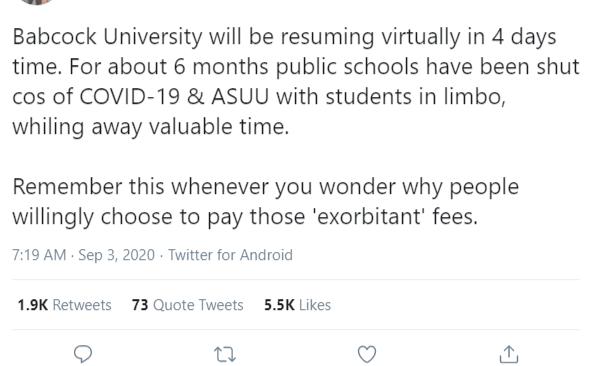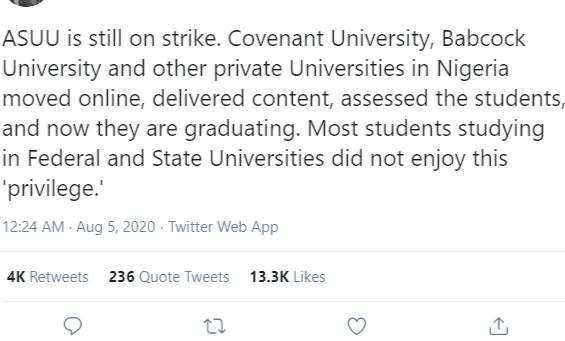
If there is one thing the COVID-19 pandemic has made glaring, it is that Nigerian public tertiary institutions are not as technologically advanced as they should be. If this were not so, academic activities would not be grounded as they currently are, the coronavirus notwithstanding. While some students of private universities have continued with their classes, written exams, submitted and defended projects, and even graduated, their public institution counterparts are not as lucky. The differentiating factor between these institutions is technology and how it is deployed or ignored.
Many years ago, chalkboards were the thing in schools. As time went on, white boards came in vogue and nearly all universities switched to this. From the 2000s, teaching evolved to using interactive white boards, projectors and other tech-driven tools. This was not a problem for most private institutions but public institutions have not fared so well.
To appreciate the current situation of things, I spoke with a cross section of (ex)students of private and public universities.
Mr O* got his B.Sc. and M.Sc. degrees, and is currently running his Ph.D. program at the Faculty of Social Science of Obafemi Awolowo University (OAU). During Okanlawon’s M.Sc. days in 2014/15, lecturers used white boards to teach. Lectures were delivered in person, hard or soft copies of reading materials were shared, assignments were submitted on paper and copies printed out for course mates. His department had an electronic board, but it was only used for special occasions – seminar presentations and the likes. Mr Okanlawon was asked if there had been a technology-dependent change in lecture delivery since his M.Sc. programme, he said there were a few, when asked to name them he said he would have to think about it.
Read Also: ASUU, NASU AND THE CONFUSION AND CACOPHONY IN THE UNIVERSITIES
A graduate of Microbiology and Medicine of the same institution, Mr Adeyinka, was asked to compare his experience as a student of different departments/ faculties in terms of tech-enabled lecture delivery.His reply: ‘Of course, there are differences in mode of lecture deliver, which in my opinion there shouldn’t be much difference. But Health Sciences explored more options. Power point presentation was the baseline but Health Sciences only did a little better.’ He added that they were able to submit assignments via email. A’s experience as a Microbiology undergraduate was quite different from this. Then, lecturers taught with white marker boards, notes were dictated, assignments were submitted on paper, and PowerPoint presentations with projectors were reserved for seminars. Mr A graduated from Microbiology in 2011 and from Medicine in 2019. While OAU is a federal university, state universities are not different in this regard. Ms Chizoba is a 2019 graduate of English Language and Education of the Olabisi Onabanjo University. According to her, her lecturers never deployed online teaching methods beyond sharing soft copies of assignments.
Like the adage says, ‘Where one man’s father’s farm ends is where another person’s father’s farm begins,’ a look at what is obtainable in private institutions is necessary here. Mr Tajudeen attends Redeemers University. Tajudeen was asked a number of questions including: how lectures are deployed, the type of boards used, how assignments are submitted, and how tests and examinations are conducted. His response: lecturers are delivered via WhatsApp, voice notes, text, PowerPoint presentations. They also use Zoom, Google Classroom, and school apps to receive lectures. School classes have both white boards and Samsung electronic boards. Assignments are submitted directly to lecturers via email or WhatsApp. Tests and exams are also conducted online.
More digging would only show the lack of and in some cases the disjointed technological advancement in public universities vis-à-vis the private ones. Which begs the questions, why the disparity? What are the effects of this disparity? And what is the way forward?


Reasons for this disparity are not hidden, except one wants to behave like the proverbial Ostrich. First, the funding available to both institutions is not the same. While most public universities charge between N20,000 – N200,000 as tuition fees per session, private universities charge between N500,000 – N1,000,000 per session. This difference in finance plays a big role in the facilities and infrastructure the universities can acquire. Since public tertiary institutions cannot charge higher fees because they are targeted at the poor and middle-income earners, they have to rely on the government to meet whatever deficits they have. The same government that allocated just 6.7% of the N10.8 trillion 2020 budget to education?
Another reason why public universities are not transitioning technologically as expected is a fear of change. Change is constant but it does not come without some resistance. Asking lecturers in their 50s, 60s, and even 70s to start holding online classes, or to upload assignments to Google Classroom, or even chat with their students via WhatsApp could be akin to asking a leopard to change its spot. Very difficult. This fear lies between ego/pride and ignorance. The Academic Staff Union of Universities (ASUU) is not helping matters. In an interview with The PUNCH newspapers published on June 16, 2020, chairman of the union, Professor Ogunyemi, had said, ‘Online teaching required some special pedagogical skills and training of lecturers who would be involved and giving them re-orientation which takes time for them to attune their minds.’ If the apex body of lecturers is saying this, who will champion the much-change?
The outcomes of this reluctance to move with the times are varied. One is the extra monies and time some graduates spend to learn some software or other hard skills that they should have learnt while in school. Those who are unable to learn these skills find themselves at a disadvantage when there’s a need for it. Another is the possible longer stay in school as seen with the current pandemic. If there was no ASUU strike, availability of robust tech-enabled learning platforms would have saved our undergraduates from an extra year as most would likely face this year.

Lack of innovation, being relegated to the background, and a further widening of the gap between the rich and the poor, are other consequences of the technological stagnation in public universities.
Is there a way forward? Definitely. It lies between resourcefulness and more funding. Public universities have to prioritise deploying technology in as many ways as they can. Some of these solutions do not cost so much if there’s the will to use them. Older lecturers also need to overcome their fear of technology and be humble enough to ask for help from the younger ones. Other avenues of funding should be explored. The government should also be ready to do beyond what they are currently doing.
A story shared by an interviewee gives hope for the future.
Mr Mustapha has three degrees from OAU and is also a lecturer there. He was asked to compare his experience as a student from 2007 – 2019 to his current role as a lecturer. In his opinion: ‘Yes, there is a massive difference in method, about 80% improvement compared to my time as a student. Though we are not there yet but a lot has changed.’
1. Classes and lectures are given on google classroom now and not used then. The Google classroom has everything you will need. Both grading and deadlines for assignments.
2. 80% of the classes where manual notes copying but now about 20% of notes copying perhaps for explanation sake while the soft copy or hard copy is given directly to the class.
3. Many at times, the students can organize a WhatsApp group for information dissemination and delivery of lecture materials which has enhanced the students-lecturers’ relationship, but in our time, we are too intimidated to be in same group if any with our lecturers.
4. 80% of tests in some levels are also CBTs.
He added that ‘this change is already sweeping across some faculties such as Education and Agriculture but the major issue is funding and it has really slow-paced the inclusion of technology in teaching method(s).’
*The names used in this article are fictitious because the respondents have requested anonymity
Oriyomi Adebare-Anthony

Good delivery, I enjoyed reading through the piece. I do hope that things change for the better in academic sector at all levels in Nigeria. It’s quite a thing going back and forth on matters like these in a country that’s almost 60😥